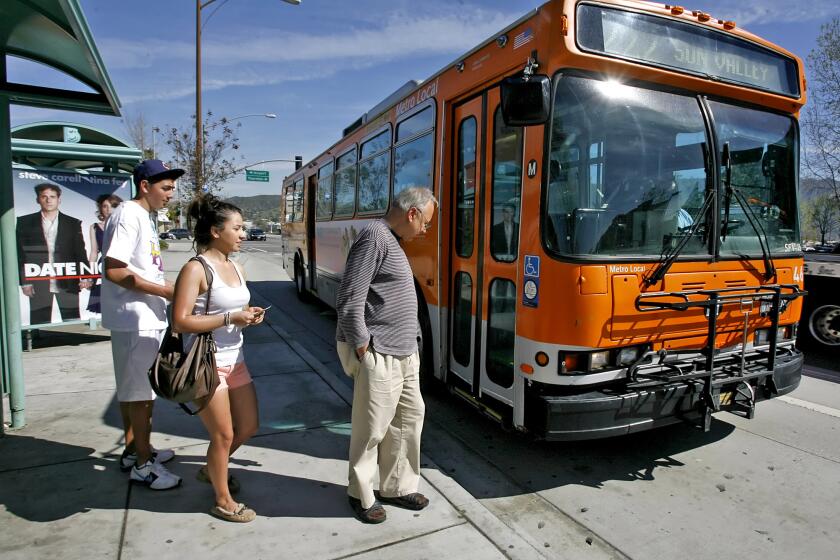Call for Cuts in Project Size at Airport Fails to Halt Protest
Santa Monica city planners are calling for a big reduction in the size of a sprawling office complex proposed for land at Santa Monica Airport, but the cutback is doing little to satisfy homeowner groups and others who oppose the project.
At the same time, developer Henry A. Lambert warns that it is “foolish” to scale back the project.
Lambert, president of the Reliance Development Group, was chosen by the city a year ago to build on a 37.5-acre plot of mostly vacant, city-owned land south of the airport.
Reliance’s plans--which immediately drew protests from neighboring homeowners and Los Angeles officials--outlined a $280-million, 1.4-million-square-foot complex of offices and movie studios.
Because the site borders Los Angeles, officials and residents there complained that they would suffer the brunt of traffic leaving and arriving at the project.
Plan for 21% Cut
In response to the groundswell of criticism, Santa Monica City Manager John Jalili said Monday that he would recommend the project be cut by 21%, or about 300,000 square feet.
The recommendation will go before the Santa Monica Planning Commission on Nov. 30.
The reduction would eliminate a fourth and final phase of the project, and about seven acres at the far-west end of the parcel would be returned to the airport, said Peggy Curran, director of Community and Economic Development for Santa Monica.
Jalili and Curran said they hoped opponents of the project--many of whom have demanded it be cut in half--would agree that Santa Monica is making a significant reduction while addressing environmental problems.
Since the city owns the land, Santa Monica stands to earn $10 million to $15 million a year in lease revenue if the larger project is built. The city would receive another $1 million for a public art fund and close to $6 million for a parks and housing fund.
Loss in Earnings
But with the proposed reduction, earnings for Santa Monica would drop by nearly $30 million over the next 25 years, Curran said.
“We are recommending this reduction despite the obvious detriment to our revenue because we feel it is a responsible approach that seeks to balance funds for the city (with) maintaining a livable city for everyone,” Curran said.
But homeowner groups and even some of Santa Monica’s elected officials remained skeptical.
Greg Thomas, a Mar Vista resident who has coordinated efforts against the project, said he would continue to press for a 50% cutback in the project and blasted Santa Monica officials for failing to sufficiently account for traffic.
“The numbers (of square footage) mean nothing unless they show us how the traffic is going to be routed,” said Thomas, who heads a group called HOME (Home Owners Monitoring the Environment).
Thomas wants to see an alternate exit and entrance that takes cars to the northern side of the airport land and away from Bundy Drive, an already congested street that forms the eastern border of the site.
“A 50% reduction to us means less cars up and down that street,” Thomas said. “It’s a number that would reflect what the area can handle.”
Thomas’ organization has joined forces with groups of homeowners in West Los Angeles and Santa Monica’s Sunset Park. He said they plan to sue Santa Monica to stop the project if steps are not taken to ease the traffic.
The suit, Thomas said, would be patterned after a pair of complaints filed last September in Superior Court by the city of Los Angeles and the Venice Town Council against Culver City to stop construction of the Marina Place shopping mall in Culver City.
Los Angeles Councilwoman Ruth Galanter, who initiated the lawsuit against Culver City, has also urged that the Santa Monica airport project be cut in half.
Galanter was out of town this week and could not be reached for comment. Galanter’s press deputy, Rick Ruiz, said Galanter’s office will study Santa Monica’s new plan but that the 50% cut was more in line with what Los Angeles wants.
‘Protect Neighborhoods’
“Our goal has not changed,” Ruiz said. “Our goal is to protect the neighborhoods around the airport. Our bottom line is that the neighborhoods around the project be free from negative impacts from the project.”
But Jalili and Curran, pointing out that the project is already much smaller than Los Angeles codes would permit in a similarly zoned area, insisted that a 50% reduction is unreasonable.
“For people to be saying cut it in half again is an arbitrary demand . . . not based on anything rational,” Curran said.
Lambert, the developer, said he was studying the 21% reduction, to see whether he could live with it, but he flatly rejected a 50% cutback.
Santa Monica would also require Reliance to build an on-site child-care center for 100 children of employees and nearby residents, as well as an on-site sewage treatment facility.
Several Santa Monica City Council members have become uneasy about the size of the project, a sentiment likely to spread in the city’s slow-growth atmosphere.
Councilman Herb Katz, who was reelected last week, said he wanted to see a specific plan for handling traffic before he could approve the project. He said the city staff has failed to look at detailed measures, such as the use of cul de sacs or limited hours for making turns, to ease the flow of traffic from the airport site.
“Square footage doesn’t tell me a thing,” Katz said of the new recommendation.
“The whole thing is how do we get traffic out of there without intruding on the neighborhoods. . . . I will not buy into this project until I see a specific plan for traffic.”
Councilman Dennis Zane, also reelected last week, said he didn’t think a 21% cut would be enough.
Support for Project
Zane and Katz said they want the project built, though not at its current size, because of the important financial benefits to the city.
The airport project has generated more protest at an earlier phase than did two recent massive office complexes, Colorado Place and Water Garden. This is apparently a source of frustration to several Santa Monica officials, since Santa Monica stands to make more money from the airport project than from the previous two complexes.
“The public benefits from Water Garden and Colorado Place are minuscule compared to the public benefits from the airport project,” Zane said. “It is ironic that there is more controversy over the (project) from which there is real public benefit.”
Jalili also has stressed the importance of the airport project to the city’s financial well-being, saying the money would pay for more police and social services. Outgoing Mayor James Conn has called the airport land a “gold mine waiting to be tapped.”
But opponents like Thomas are not swayed by those arguments.
“If their rationale is they need the money, well, we’ve heard that (argument) from bank robbers, drug dealers and prostitutes,” Thomas said.
More to Read
Start your day right
Sign up for Essential California for news, features and recommendations from the L.A. Times and beyond in your inbox six days a week.
You may occasionally receive promotional content from the Los Angeles Times.







